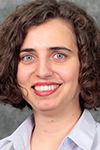Awardees Suggest Applying Widely When Looking for NSF Grant
Steve Pierson, ASA Director of Science Policy
To strengthen the connection between the statistical community and National Science Foundation, we continue the series introduced in the May 2023 issue that poses questions to NSF program officers and awardees. If you have questions or comments for the program officers, send them to ASA Director of Science Policy Steve Pierson.Program Director
 Jun Zhu is on leave from the University of Wisconsin-Madison. This is her second year as a rotator program director of the statistics program of the Division of Mathematical Sciences in the NSF Directorate for Physical and Mathematical Sciences.
Jun Zhu is on leave from the University of Wisconsin-Madison. This is her second year as a rotator program director of the statistics program of the Division of Mathematical Sciences in the NSF Directorate for Physical and Mathematical Sciences.What kind of funding opportunities are there at the NSF for graduate students?
The Graduate Research Fellowship Program is an NSF agency-wide program that ensures the quality, vitality, and diversity of the US scientific and engineering workforce.
What kind of funding opportunities are there at the NSF for postdocs?
There are two postdoctoral fellowship programs available: the Mathematical Sciences Postdoctoral Research Fellowship (MSPRF) and the Mathematical and Physical Sciences Ascending Postdoctoral Research Fellowship (MPS-Ascend). MSPRF supports postdoctoral fellows pursuing research and training in mathematics and statistics, including their applications to other disciplines. MPS-Ascend supports postdoctoral fellows performing impactful research in mathematical and physical sciences fields while broadening the participation of underrepresented groups in the mathematical and physical sciences.
You may apply for both postdoctoral programs; however, the MPS-Ascend solicitation states you “may not submit a research plan duplicated in another NSF proposal currently under consideration.”
Awardees
 Amy Herring is Sara and Charles Ayres Distinguished Professor of Statistical Science at Duke University and president of the International Society for Bayesian Analysis. Her research interests include Bayesian methods, complex data structures, dimension reduction methods, and applications in health science.
Amy Herring is Sara and Charles Ayres Distinguished Professor of Statistical Science at Duke University and president of the International Society for Bayesian Analysis. Her research interests include Bayesian methods, complex data structures, dimension reduction methods, and applications in health science.
 Jingchen (Monika) Hu is associate professor of mathematics and statistics at Vassar College. She teaches an undergraduate Bayesian course there and is co-author of Probability and Bayesian Modeling. In her research, she works on statistical data privacy.
Jingchen (Monika) Hu is associate professor of mathematics and statistics at Vassar College. She teaches an undergraduate Bayesian course there and is co-author of Probability and Bayesian Modeling. In her research, she works on statistical data privacy.

“QREM Headshots at the Ohio Union of The Ohio State University in Columbus, Ohio in on Friday, February 13, 2015. (Joshua Orack/Ohio State University Office of Student Life)”
Mine Dogucu, Amy Herring, and Jingchen (Monika) Hu were recently awarded NSF funding to advance Bayesian thinking in STEM. Prior to this project, which they refer to as Bayes BATS, they did not have extensive experience with the NSF proposal process. Herring was mostly experienced with other federal agencies. Dogucu had one project successfully funded through the NSF’s Data Science Corps program, and Hu had an ASA/NSF/BLS fellowship earlier in her career. Throughout the proposal writing process, they supported each other and relied on staff support. Dogucu, Herring, and Hu collectively responded to the following questions.
What NSF non-DMS entity funded or contributed, and how will funding be used?
Bayes BATS is funded through the NSF’s Directorate for STEM Education (EDU), specifically the Improving Undergraduate STEM Education (IUSE) program. The University of California at Irvine, Vassar College, and Duke University are the three collaborating institutions. The funding mostly supports STEM instructors from a wide range of disciplines in learning how to use and teach Bayesian methods.
In Tier 1 of the program, we host a one-week, in-person bootcamp. In Tier 2, we mentor instructors as they develop instructional materials for their own STEM courses, and in Tier 3, we support instructors in disseminating their instructional materials through national conferences and open-access publications.
What will this proposal accomplish?
The BATS project objectives are the following:
- Increase the number of undergraduate students exposed to Bayesian methods
- Enhance the capacity of STEM instructors in Bayesian methods through training and community building
- Develop and enrich teaching and learning materials that showcase the use of Bayesian methods in STEM fields
What was your approach to the Directorate for STEM Education?
There are many opportunities for statisticians outside of DMS. There is a suggestion about grant writing that goes “write the project you want to see in the world and then find funding for it.” This was true in our case. Through our project, we want to see Bayesian methods more widely used in scientific practice, and we believe that is possible through curricular change. We want STEM curricula to include Bayesian methods. EDU’s IUSE program was a perfect fit for the type of impact we wanted to create in the scientific community. Once we identified the program, we were able to work on the details of the proposal through in-depth reading of the solicitation and looking at examples of what had been previously funded by the program.
What advice do you have for others applying for NSF funding?
- Apply ‘widely.’ DMS is not the only source of funding for statisticians and data scientists within NSF.
- Work closely with your grants office staff. They know the process and are up to date on new forms and regulations.
- Talk to program officers. Program officers provide a wealth of information that can go beyond online resources.


















Leave your response!